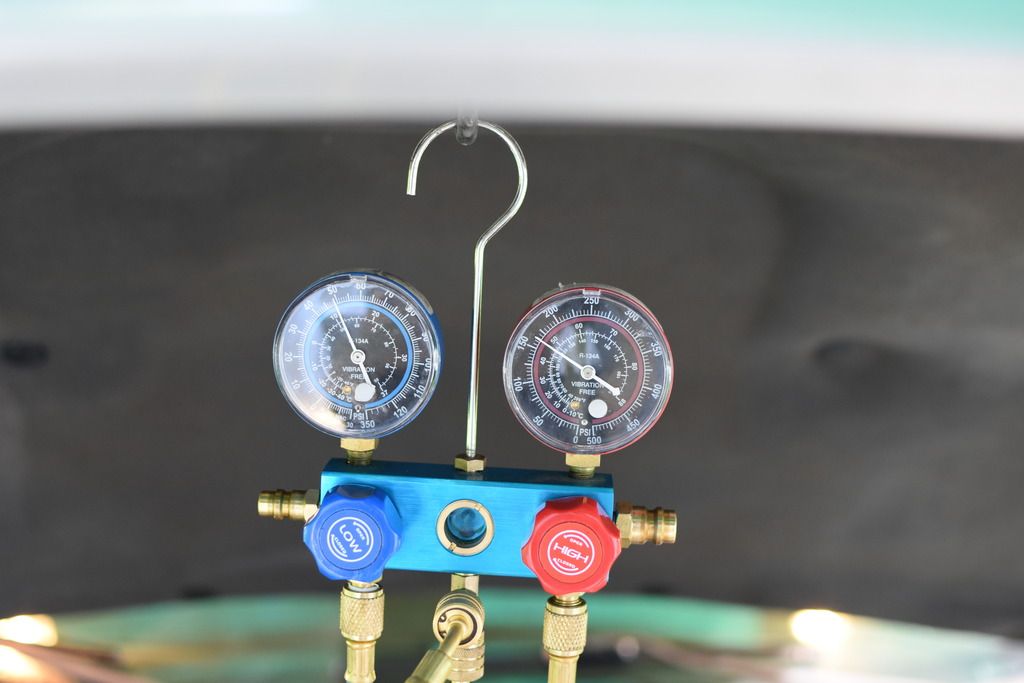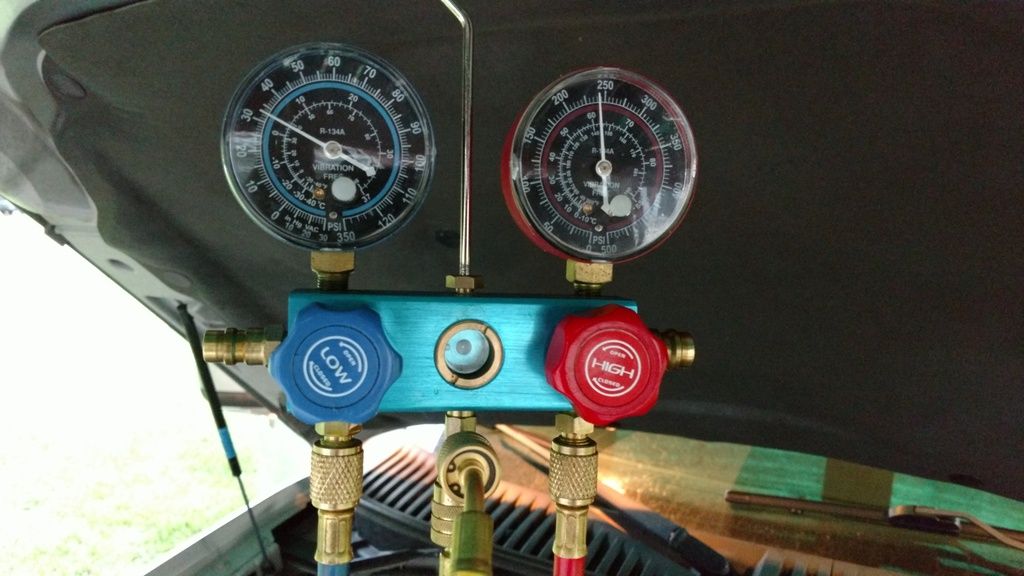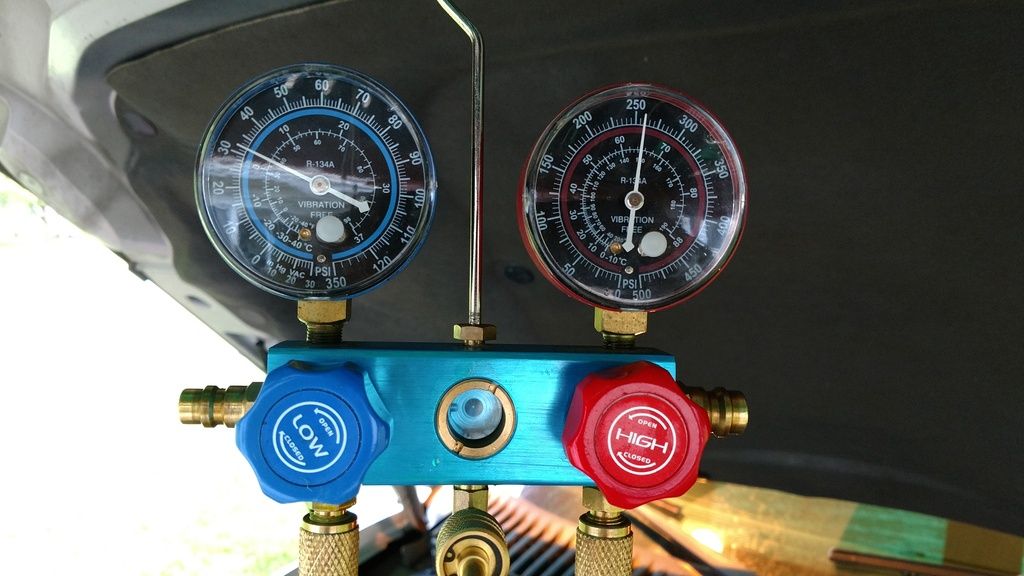2005 Navigator - Replaced nearly entire A/C system, still won't blow cold enough
Posted: Sun May 14, 2017 8:08 pm
Hi everyone, I bought a well-maintained '05 Navigator last year, with around 110,000 miles on the odometer. Once summer came around, I noticed the A/C wasn't very cold. I put a thermometer in the dash vents and on the coldest setting, in recirculating mode, I was only getting around 49 or so degrees Fahrenheit out of the vents. This was true to both the front A/C system as well as the separate, rear A/C system. Thinking it was low on refrigerant I bought a re-charge kit. I hooked it up to the low pressure port and before piercing the can of R134A open I noticed the pressure was a little low according to the range it should have been based on the ambient temperature. The system sucked down the entire large can. I drove it for a few minutes and the A/C system didn't really improve. I bought another large can, and it sucked it right down. Drive it for a few days and the system was still putting out 49-51 degrees, and by the way, to get the temperatures down this low I had to drive it on the highway for 20+ minutes. Stop and go driving wouldn't get the temps under 55 on a hot day here in Maryland. Thinking the system must've been REALLY low on refrigerant, I added a third large can to the system. It sucked it right down, too, and the gauge never reach 40-50 PSI on the low side. Frustrated I stopped driving the car on hot days and drive my other car. A few days later, I found I had blown out the front compressor seal on the Navigator. I over-charged the system, thinking the low pressure gauge one each can I used was the ultimate deciding factor as to how much refrigerant I was needing.
At this point I did some research and learned a bit more about automotive A/C systems. I ordered a new compressor, condenser, filter/drier, expansion valves, and o-rings. I removed everything (including expansion valves), ran flush through the A/C lines on the body of the vehicle (all of the other lines under the hood were replaced), followed behind with air to blow the flush chemical out, installed everything, and used the proper amount of (dyed) PAG oil. I got a good deal on a Robin-Air Cool-Tech A/C machine, and did a standard vacuum check (15 minutes). The system passed the vacuum check...... but I noticed the needles on the high and low gauges of the A/C machine had dropped a little. I decided to run the vacuum pump for two hours to remove all moisture, and I noticed that after sitting for 40 minutes with the vacuum pump off but the system still connected, I had lost nearly all vacuum. Not sure if there was possibly a leak in the A/C machine, I used my buddy's gauges with new seals and all. We used his commercial vacuum pump in junction with his gauges, and same thing-- you could see the vacuum decrease after 10 minutes. We then pumped 150 PSI of nitrogen into the system and sprayed around several joints for leaks. Nothing. And we could watch the pressure of the nitrogen drop. I determined there was definitely a leak, but the summer was now over and I decided I'd wait till next year.
Well, here I am, 2017, it's getting warm, and I'm back to chasing down this problem. I had a buddy use his Snap-On A/C machines and do a 15 minute vacuum and recharge my system. I noticed that sitting still I was barely getting under 55 degrees out of the vents immediately after this, and on 70-degree day. I used his Snap-On refrigerant leak detector / sniffer, and check the entire engine compartment of A/C lines, under the car, the rear A/C system, etc. I was even able to pop the sniffer into the front and rear evaporator plenums. I did all of this while the engine was running and no leak was detected anywhere. I headed back down the highway to my house and after a but of driving the A/C came down to 45 degrees out of the vents. It was still only 70 degrees out, and the interior was not heat-soaked whatsoever. So it was obviously performing very poorly.
I waited till night time and took my yellow shades and my two nice UV flash lights and checked everything under the hood first. Not a single sign of a leak anywhere. Checked the condenser up and down, the filter/drier, the compressor, all of the lines, the schrader valves on the high and low pressure ports, the expansion valves.... every joint under the hood..... and nothing. I checked the lines running to the rear A/C system and they were fine. I then took my borescope and looked in the front and rear evaporator plenums-- first with normal lighting the make sure they were clean (NO debris, dirt, dust, etc on either of the evaporators, by the way), and then checked them with my UV light. No leaks there either. I've checked literally everything.
It has now been 4 weeks and I somehow seemed to be holding charge, despite not being able to hold vacuum nor nitrogen at the end of last summer, because my system continues to have somewhat cold air. On warmer days it takes a lot longer to cool down, and I always only use recirculating mode, though I've tried pulling it outside air and that didn't help of course. Today was around 77 degrees and I was able to get around 48 degrees out of the vents at best.
The buddy of mine with the Snap-On A/C machine and sniffer said it must be a bad compressor or expansion valve(s).... even though all of those are new. I'd hate to go tearing into any of those again on a whim, especially since all of the last components (the original components) gave the same problem with the system not being able to break below 45 degrees, even after hours of highway driving and the A/C on full blast (and a cool cabin temperature). It just seems like something is maxing out. The only things I haven't replaced (aside from some of the lines) is the front and rear evaporator. But again, they're not clogged with debris to minimize their efficiency, and neither of them seem to be leaking. Some might say that 48 degrees coming out of the vents is perfectly fine, but it's definitely not. The A/C seems to perform less as the ambient temperature increases, or just takes a good bit longer to cool as the ambient temperature increases, even when the cabin is relatively cool. The system should be able to get down to around 40 degrees coming out of the vents. Every Ford I've had ('92 Taurus SHO, '93 Lightning, '96 Taurus SHO, '98 Expedition, '98 Contour SVT) have all been R134A systems (what wasn't originally was converted) and all blew no warmer than 40 degrees out of the vents. And the systems didn't struggle to put out cold air when idling.
Something seems really out of whack about this system and I just can't seem to put my finger on it. I'm beginning to wonder if it's a component affiliated with the electronic climate control system (the part in the dash)... but then again, the rear A/C system is manually controlled (it uses knobs).
To further show some of the oddities, here are some pictures I took when the buddy with the Snap-On machine suggested I check my pressures with the engine running and the A/C system on. The pictures are in order, and the pressures hovered down low for a little bit, then after time started shooting up. Way up. I don't get it. The high and low pressures stay about equal, and I thought they only equalize after the system has been turned off and things settle, not while the A/C system is running??
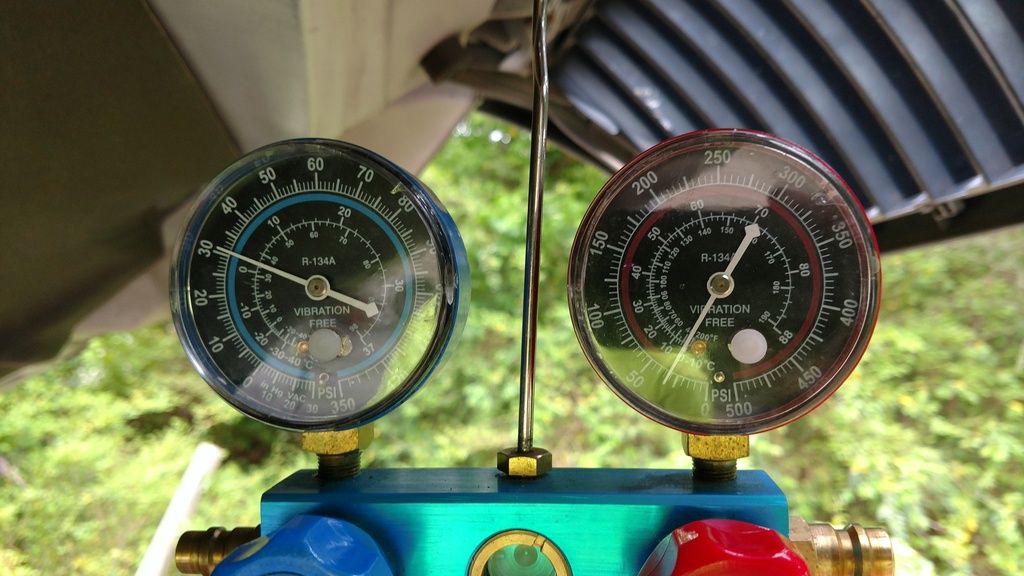
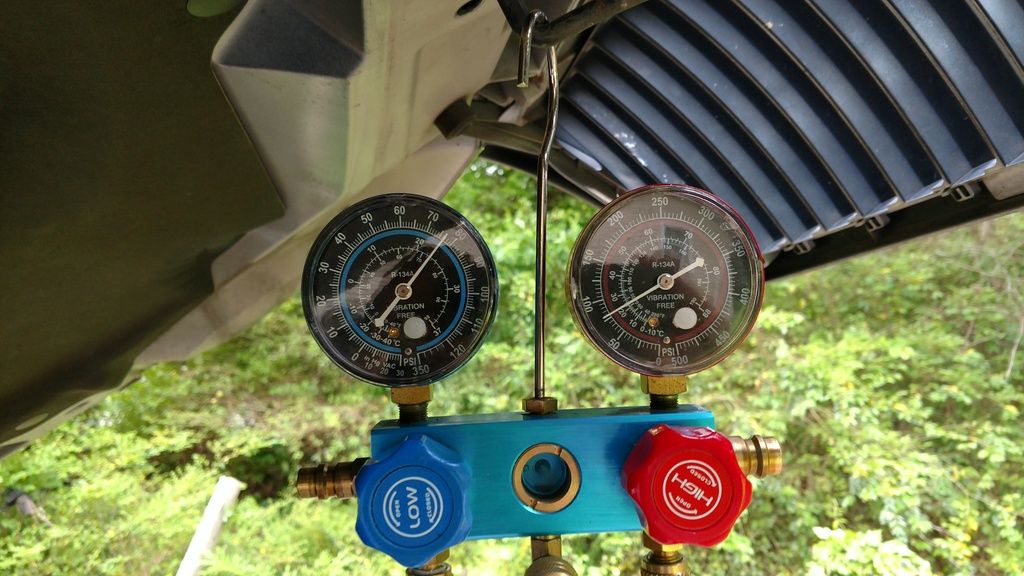
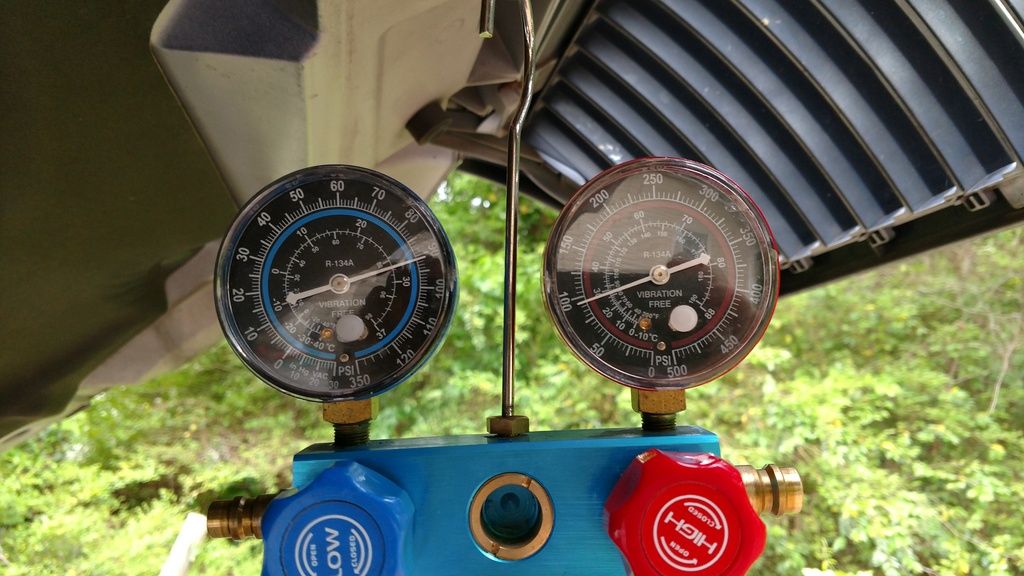
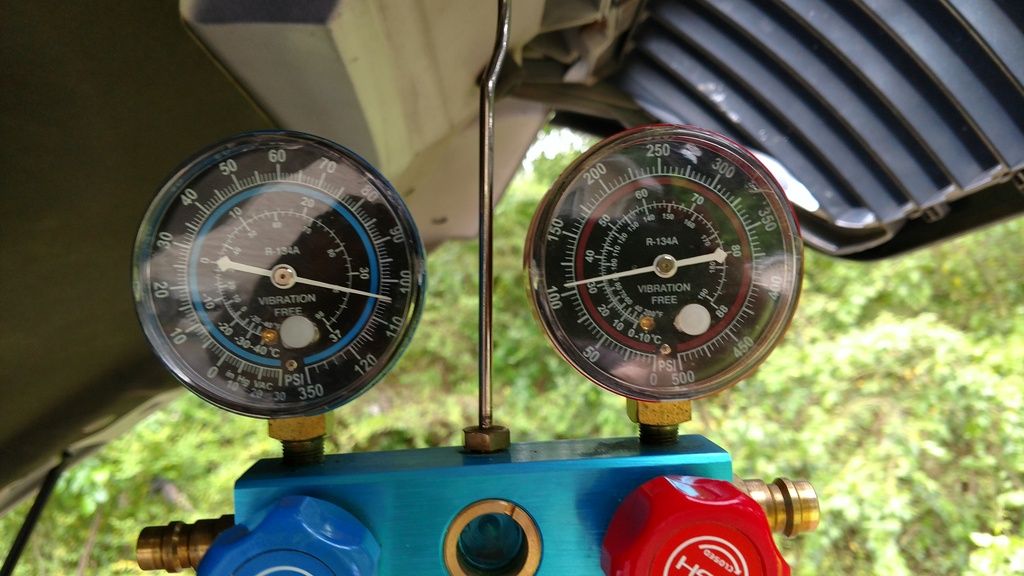
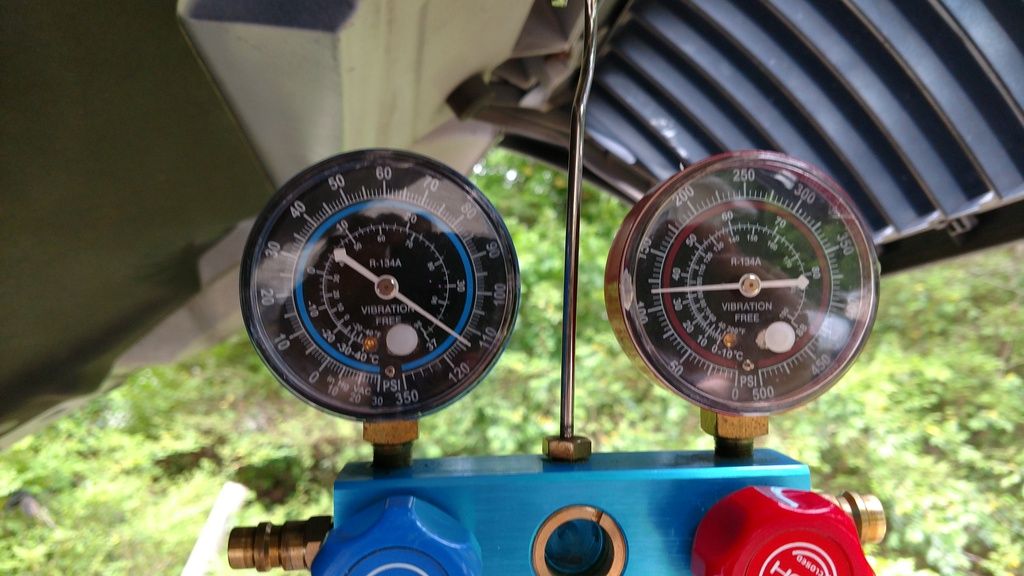
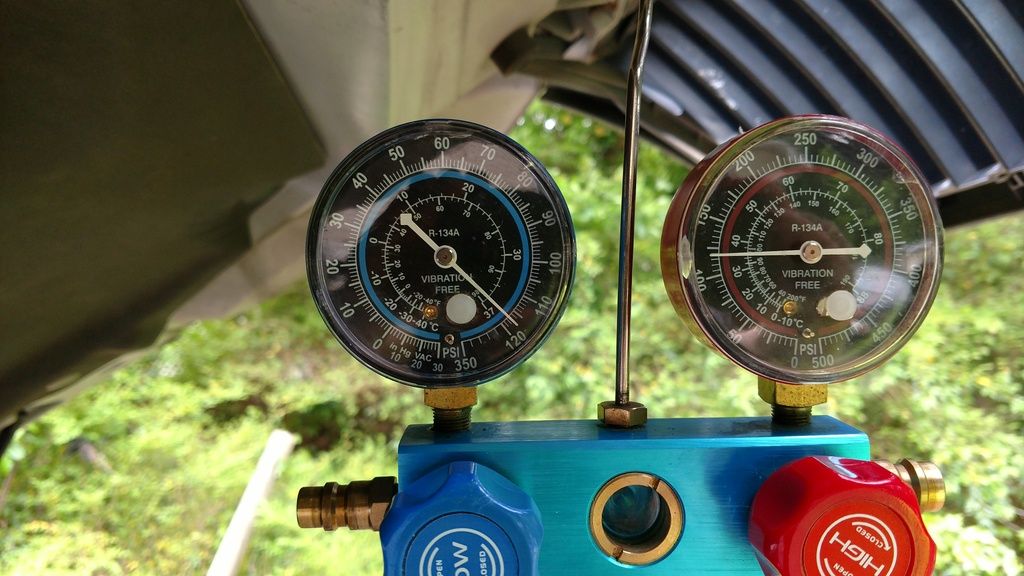
The compressor was still cycling on and off (not short-cycling) the entire time I took all of those pictures, and prior to taking the pictures, when first connected the gauges and the pressures were on the lower side.
Sorry for the extremely long-winded post.... but I just want to make sure I explain every littler bit that I can of this entire journey I've been through to weed out any basic stuff, in hopes for suggestions of something I haven't already tried. Any solid help on this would be extremely appreciated... summer is on it's way here in Maryland and I can't go another year of 90 degree days and a really poor-performing A/C system on this truck. Thanks a bunch!!!
-Andrew
At this point I did some research and learned a bit more about automotive A/C systems. I ordered a new compressor, condenser, filter/drier, expansion valves, and o-rings. I removed everything (including expansion valves), ran flush through the A/C lines on the body of the vehicle (all of the other lines under the hood were replaced), followed behind with air to blow the flush chemical out, installed everything, and used the proper amount of (dyed) PAG oil. I got a good deal on a Robin-Air Cool-Tech A/C machine, and did a standard vacuum check (15 minutes). The system passed the vacuum check...... but I noticed the needles on the high and low gauges of the A/C machine had dropped a little. I decided to run the vacuum pump for two hours to remove all moisture, and I noticed that after sitting for 40 minutes with the vacuum pump off but the system still connected, I had lost nearly all vacuum. Not sure if there was possibly a leak in the A/C machine, I used my buddy's gauges with new seals and all. We used his commercial vacuum pump in junction with his gauges, and same thing-- you could see the vacuum decrease after 10 minutes. We then pumped 150 PSI of nitrogen into the system and sprayed around several joints for leaks. Nothing. And we could watch the pressure of the nitrogen drop. I determined there was definitely a leak, but the summer was now over and I decided I'd wait till next year.
Well, here I am, 2017, it's getting warm, and I'm back to chasing down this problem. I had a buddy use his Snap-On A/C machines and do a 15 minute vacuum and recharge my system. I noticed that sitting still I was barely getting under 55 degrees out of the vents immediately after this, and on 70-degree day. I used his Snap-On refrigerant leak detector / sniffer, and check the entire engine compartment of A/C lines, under the car, the rear A/C system, etc. I was even able to pop the sniffer into the front and rear evaporator plenums. I did all of this while the engine was running and no leak was detected anywhere. I headed back down the highway to my house and after a but of driving the A/C came down to 45 degrees out of the vents. It was still only 70 degrees out, and the interior was not heat-soaked whatsoever. So it was obviously performing very poorly.
I waited till night time and took my yellow shades and my two nice UV flash lights and checked everything under the hood first. Not a single sign of a leak anywhere. Checked the condenser up and down, the filter/drier, the compressor, all of the lines, the schrader valves on the high and low pressure ports, the expansion valves.... every joint under the hood..... and nothing. I checked the lines running to the rear A/C system and they were fine. I then took my borescope and looked in the front and rear evaporator plenums-- first with normal lighting the make sure they were clean (NO debris, dirt, dust, etc on either of the evaporators, by the way), and then checked them with my UV light. No leaks there either. I've checked literally everything.
It has now been 4 weeks and I somehow seemed to be holding charge, despite not being able to hold vacuum nor nitrogen at the end of last summer, because my system continues to have somewhat cold air. On warmer days it takes a lot longer to cool down, and I always only use recirculating mode, though I've tried pulling it outside air and that didn't help of course. Today was around 77 degrees and I was able to get around 48 degrees out of the vents at best.
The buddy of mine with the Snap-On A/C machine and sniffer said it must be a bad compressor or expansion valve(s).... even though all of those are new. I'd hate to go tearing into any of those again on a whim, especially since all of the last components (the original components) gave the same problem with the system not being able to break below 45 degrees, even after hours of highway driving and the A/C on full blast (and a cool cabin temperature). It just seems like something is maxing out. The only things I haven't replaced (aside from some of the lines) is the front and rear evaporator. But again, they're not clogged with debris to minimize their efficiency, and neither of them seem to be leaking. Some might say that 48 degrees coming out of the vents is perfectly fine, but it's definitely not. The A/C seems to perform less as the ambient temperature increases, or just takes a good bit longer to cool as the ambient temperature increases, even when the cabin is relatively cool. The system should be able to get down to around 40 degrees coming out of the vents. Every Ford I've had ('92 Taurus SHO, '93 Lightning, '96 Taurus SHO, '98 Expedition, '98 Contour SVT) have all been R134A systems (what wasn't originally was converted) and all blew no warmer than 40 degrees out of the vents. And the systems didn't struggle to put out cold air when idling.
Something seems really out of whack about this system and I just can't seem to put my finger on it. I'm beginning to wonder if it's a component affiliated with the electronic climate control system (the part in the dash)... but then again, the rear A/C system is manually controlled (it uses knobs).
To further show some of the oddities, here are some pictures I took when the buddy with the Snap-On machine suggested I check my pressures with the engine running and the A/C system on. The pictures are in order, and the pressures hovered down low for a little bit, then after time started shooting up. Way up. I don't get it. The high and low pressures stay about equal, and I thought they only equalize after the system has been turned off and things settle, not while the A/C system is running??






The compressor was still cycling on and off (not short-cycling) the entire time I took all of those pictures, and prior to taking the pictures, when first connected the gauges and the pressures were on the lower side.
Sorry for the extremely long-winded post.... but I just want to make sure I explain every littler bit that I can of this entire journey I've been through to weed out any basic stuff, in hopes for suggestions of something I haven't already tried. Any solid help on this would be extremely appreciated... summer is on it's way here in Maryland and I can't go another year of 90 degree days and a really poor-performing A/C system on this truck. Thanks a bunch!!!
-Andrew
